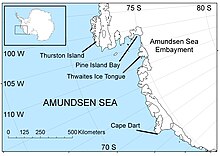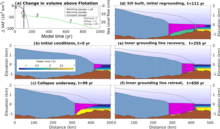Amundsen Sea


The Amundsen Sea is an arm of the
The sea is mostly ice-covered, and the Thwaites Ice Tongue protrudes into it. The ice sheet which drains into the Amundsen Sea averages about 3 km (1.9 mi) in thickness; roughly the size of the state of Texas, this area is known as the Amundsen Sea Embayment (ASE); it forms one of the three major ice-drainage basins of the West Antarctic Ice Sheet.
Embayment

The ice sheet that drains into the Amundsen Sea averages about 3 km (1.9 mi) in thickness. It is roughly the size of the state of Texas and is known as the Amundsen Sea Embayment (ASE); it forms one of the three major ice drainage basins of the
Some scientists proposed that this region may be a weak underbelly of the
A 2004 study suggested that because the ice in the Amundsen Sea had been melting rapidly and was riven with cracks, the offshore ice shelf was set to collapse "within five years". The study projected a sea level rise of 1.3 m (4.3 ft) from the West Antarctic Ice Sheet if all the sea ice in the Amundsen Sea melted.[3]
Measurements made by the British Antarctic Survey in 2005 showed that the ice discharge rate into the Amundsen Sea embayment was about 250 km3 per year. Assuming a steady rate of discharge, this alone was sufficient to raise global sea levels by 0.2 mm per year.[4]
A subglacial

In January 2010, a modelling study suggested that the "tipping point" for Pine Island Glacier may have been passed in 1996, with a retreat of 200 kilometers (120 miles) possible by 2100, producing a corresponding 24 cm (0.79 ft) of sea level rise. It was suggested that these estimates were conservative.[11] The modelling study also stated that "Given the complex, three-dimensional nature of the real Pine Island glacier ... it should be clear that the [...] model is a very crude representation of reality."[12]
A 2023 study estimated that the area lost 3.3 trillion tons of ice between 1996 and 2021, raising sea levels by 9 millimeters.
Pine Island Bay
Pine Island Bay (74°50′S 102°40′W / 74.833°S 102.667°W) is a bay about 40 miles (64 km) long and 30 miles (48 km) wide, into which flows the ice of the
Russell Bay
Russell Bay (73°27′S 123°54′W / 73.450°S 123.900°W) is a rather open bay in southwestern Amundsen Sea, extending along the north sides of
Climate engineering

Some engineering interventions have been proposed for Thwaites Glacier and the nearby
In 2023, a modified proposal was tabled: it was proposed that an installation of underwater "curtains", made out of a flexible material and anchored to Amundsen Sea floor would be able to interrupt warm water flow while reducing costs and increasing their longevity (conservatively estimated at 25 years for curtain elements and up to 100 years for the foundations) relative to more rigid structures. With them in place, Thwaites Ice Shelf and Pine Island Ice Shelf would presumably be able to regrow to a state they last had a century ago, thus stabilizing these glaciers.[19][20][17] To achieve this, the curtains would have to be placed at a depth of around 600 metres (0.37 miles) (to avoid damage from icebergs which would be regularly drifting above) and be 80 km (50 mi) long. The authors acknowledged that while work on this scale would be unprecedented and face many challenges in the Antarctic (including polar night and the currently insufficient numbers of specialized polar ships and underwater vessels), it would also not require any new technology and there is already experience of laying down pipelines at such depths.[19][20]

References
- ^ "Amundsen Sea". Geographic Names Information System. United States Geological Survey. Retrieved 23 October 2011.
- ^
Pearce, Fred (2007). With Speed and Violence: Why scientists fear tipping points in climate change. Beacon Press Books. ISBN 978-0-8070-8576-9.
- ^
Flannery, Tim F. (2006). The Weather Makers: How man is changing the climate and what it means for life on Earth. HarperCollins. pp. 356. ISBN 978-0-00-200751-1.
- ^ Strom, Robert (2007). "The Melting Earth". Hot House: Global Climate Change and the Human Condition. Coprenicus Books. p. 302.
- ^
Black, Richard (20 January 2008). "Ancient Antarctic eruption noted". BBC. Retrieved 22 October 2011.
- ^
Corr, H. F. J.; Vaughan, D. G. (2008). "A recent volcanic eruption beneath the West Antarctic ice sheet". doi:10.1038/ngeo106.
- ^ Mosher, Dave (20 January 2008). "Buried Volcano Discovered in Antarctica". Imaginova Corp. LiveScience.com. Retrieved 11 April 2009.
- ^
Payne, A. J.; Vieli, A.; Shepherd, A. P.; Wingham, D. J.; Rignot, E. (2004). "Recent dramatic thinning of largest West Antarctic ice stream triggered by oceans". S2CID 4891690.
- ^ Shepherd, A. P.; Wingham, D. J.; Rignot, E. (2004). "Warm ocean is eroding West Antarctic Ice Sheet" (PDF). .
- ^
Thoma, M.; Jenkins, A.; Holland, D.; Jacobs, S. (2008). "Modelling Circumpolar Deep Water intrusions on the Amundsen Sea continental shelf, Antarctica" (PDF). S2CID 55937812.
- ^ Barley, Shanta (13 January 2010). "Major Antarctic glacier is 'past its tipping point'". Reed Business Information Ltd. New Scientist. Archived from the original on 16 January 2010. Retrieved 17 January 2010.
- ^ Katz, R. F.; Worster, M.G. (2010). "Stability of ice sheet grounding lines". .
- ^ "Pine Island Bay". Geographic Names Information System. United States Geological Survey. Retrieved 23 October 2011.
- ^ "Russell Bay". Geographic Names Information System. United States Geological Survey. Retrieved 23 October 2011.
- ^ S2CID 52969664.
- S2CID 206554077.
- ^ a b c d James Temple (14 January 2022). "The radical intervention that might save the "doomsday" glacier". MIT Technology Review. Retrieved 19 July 2023.
- PMID 29695853.
- ^ PMID 37007716.
- ^ PMID 37091546.
- Lubin, Dan; Massom, Robert (2006). Polar Remote Sensing. New York: Springer.
- Schnellnhuber, Hans Joachim, ed. (2006). Avoiding Dangerous Climate Change. Cambridge: Cambridge University Press.
